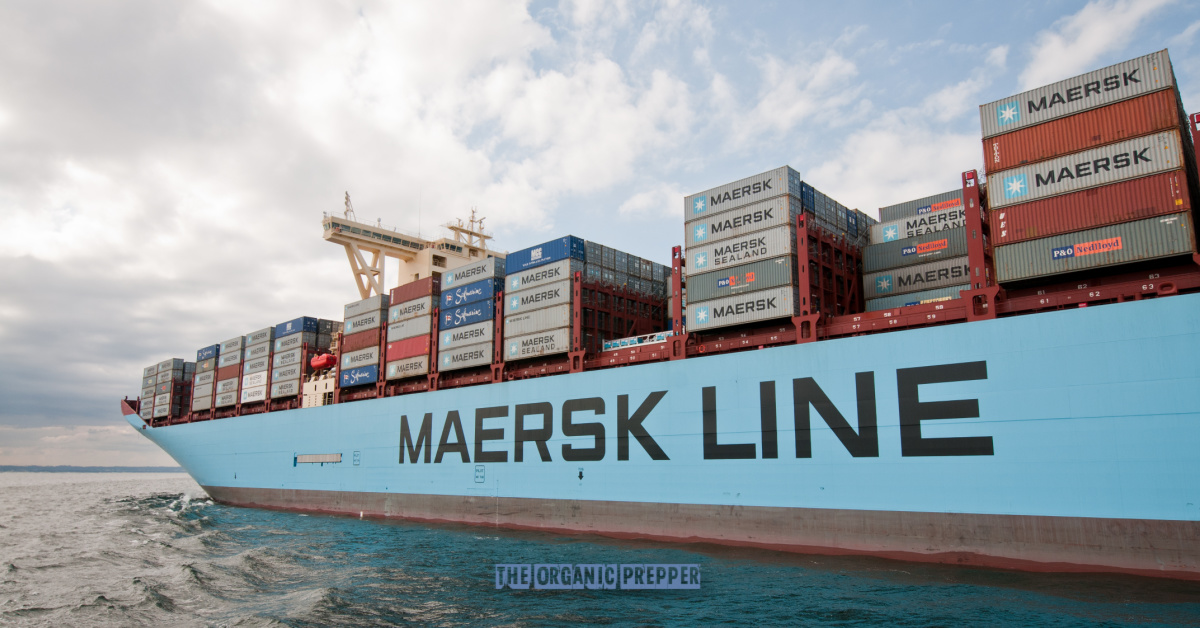(Psst: The FTC wants me to remind you that this website contains affiliate links. That means if you make a purchase from a link you click on, I might receive a small commission. This does not increase the price you’ll pay for that item nor does it decrease the awesomeness of the item. ~ Daisy)
Author of How to Prep When You’re Broke and Bloom Where You’re Planted online course
Last weekend was an eventful one in the Red Sea. Houthi rebel groups have been mercilessly attacking commercial vessels using the passage with drones, and now they’ve upped their game by directly attacking a Maersk cargo ship with missiles and attempting to board, despite the Pentagon rolling out “Operation Prosperity Guardian.”
This is a conflict that could directly affect us by increasing consumer prices for fuel and goods. Let me explain.
What happened to the Maersk ship?
The Maersk Hangzhou was sailing through the normal route on the Red Sea when on Dec. 30, they were attacked by multiple Houthi missiles and hit by one. American naval ships, the USS Laboon and the USS Gravely, responded to distress calls. Gravely intercepted two missiles meant for the ship.
The following day, the situation grew more dire when the Houthi group got bolder. A squadron of four armed boats came within 20 yards of the Maersk ship and attempted to board. They were held off by on-ship security contractors. This time, helicopters from the USS Dwight D. Eisenhower and the USS Gravely responded to the distress call and were engaged by the Houthi. The helicopters returned fire and downed three of the four attacking ships. Ten Houthi crew members died in the attack, and the fourth ship escaped.
Maersk has paused operations in the Red Sea for 48 hours and will decide today whether or not they’ll resume use of that route. Other shipping companies, Hapag-Lloyd, MSC Mediterranean Shipping Company, and Evergreen, have already rerouted their cargo around Africa. BP and Euronav have also suspended passage through the Red Sea.
Now Iran is getting involved.
A spokesperson for the Houthi group has warned of “consequences and repercussions” due to the “aggression” of the US. ZeroHedge reports:
Houthi military spokesman Yahya Sarea confirmed on the Yemeni TV channel Al-Masirah that US forces killed ten of its fighters.
“US enemy forces attacked three boats belonging to the Yemeni Naval Forces, which led to the martyrdom and the loss of ten people from the Naval Forces,” Sarea said.
The spokesman said its fighters were “performing their humanitarian and moral duty” to deter Israel-related commercial vessels from transiting the Red Sea “in solidarity and support for the Palestinian people.”
Subsequently, Iran has dispatched the Alborz destroyer to the Red Sea to provide support for the Houthi. This seems to be a significant escalation and direct challenge to the American naval presence in the area.
When are we going to admit we’re at war?
Here’s how all this affects us.
Why should we care about the Red Sea? Isn’t that just a Middle East problem? Don’t we need to stay out of it?
It’s not that simple, really.
It’s a huge route for global trade. The Hill reports:
The Red Sea is a major shipping lane route, facilitating roughly 10 percent of the world’s commerce each year.
Sailing through the Suez Canal and down the Red Sea and Gulf of Aden offers a shortcut connecting Europe to Asia and the Pacific region; it is used by about one-third of global shipping companies.
Rerouting all the way around Africa adds some 3,000 nautical miles and up to two weeks of travel, and shipping companies are now adding the extra costs as a transit disruption surcharge or a war risk surcharge, as referred to by Israeli shipping company ZIM.
“Diverting vessels around the Cape of Good Hope to mitigate the ongoing risks of sailing through the region is a necessary step in the interest of safety, but it has ultimately brought about increased costs for carriers,” said Danish shipping giant Maersk in an advisory.
The reroutes affect 17 percent of global shipping traffic, and cargo costs for carriers are expected to soar 15 to 20 percent, according to the American Journal of Transportation.
So, our prices have already skyrocketed, and now the transportation to get things like oil and merchandise to the US are going to go up by 15-20%.
For clarity, here’s a map from The BBC, credited to Veson Nautical.
How bad will the inflation from this be?
Alan Deardorff, a professor emeritus of public policy and economics at the University of Michigan seems to think that all the cost won’t be passed on to us. He believes that consumers will be affected but that “the greater cost will be on shipping companies and their suppliers.”
“They’re [consumers] going to be hurt by it, absolutely,” he said, but noted there would be a limit in how much that could trickle down. “The effect on average price and the effect on inflation might be measurable, but I don’t think it’s going to be something people will correctly notice.”
I’m no professor emeritus, but I think it would be naive to think that cost won’t be noticeably and quickly passed on to us, the consumers.
When the price of oil is involved, that increases the price of every single thing we purchase due to transportation. And oil prices have already inched up 2% since BP suspended their Red Sea routes.
A report from CNN Business warns:
“The Red Sea, especially with the Suez Canal, is like a superhighway for shipping containers, connecting different parts of the world, particularly Europe, Asia and Africa,” said Christian Roeloffs, CEO of Container xChange, a platform that facilitates container leasing. “A huge amount of Europe’s energy supply, palm oil and grain come through the Suez Canal Waterway.”
Such is the importance of the route that the United States launched a naval mission Monday with nine other countries to protect commercial shipping in the Red Sea.
“The Red Sea is a critical waterway that has been essential to freedom of navigation and a major commercial corridor that facilitates international trade,” US Secretary of Defense Lloyd Austin said as he announced the initiative.
“As a result of these attacks, freight and insurance rates have already increased, and oil prices are going up.”
Shipping lanes in the Red Sea “are crucial to the stability of the global economy,” he added.
How much will things go up?
Remember back when that ship was grounded in the Suez Canal, and it took forever to get things moving again? We looked at the additional costs of routing around the Canal then and the reroute for the Red Sea is the same. We reported at the time:
Jonathan Roach, a container market analyst for Braemar ACM Shipbroking, told NPR:
“The large container ships, the super, mega-max container ships, can burn 100 [to] 150 tons of fuel a day,” Braemar ACM Shipbroking’s Roach told NPR.
That’s $80,000 a day in fuel and an extra 10 days travel time — both to and from Asia. “So, you’re looking at the best part of a million dollars with your operating costs. So it’s a million dollars out and a million dollars back,” he said.
In his letter to clients, Roach also noted problems at the Suez Canal could disrupt the flow of containers. A trade imbalance between Europe and Asia means that filled containers going west return mostly empty to ports in the east to be refilled. “If empty stocks dwindle in Asia, there is the short-term possibility of an increase” in prices, Roach wrote.
If this situation isn’t resolved in a hurry, we can expect more price increases and more delays for goods coming to Europe and the United States. And with Iran getting involved, hopes for a speedy resolution seem slim.
What are your thoughts?
How do you think the situation in the Red Sea should be handled? Should that shipping route be abandoned in an effort to reduce conflict with the region? Do you think Iran’s presence will escalate the skirmishes? Do you expect to see much higher prices due to this? And finally, will this be the spark that truly ignites World War III?
Let’s hear your thoughts in the comments section.
About Daisy
Daisy Luther is a coffee-swigging, adventure-seeking, globe-trotting blogger. She is the founder and publisher of three websites. 1) The Organic Prepper, which is about current events, preparedness, self-reliance, and the pursuit of liberty; 2) The Frugalite, a website with thrifty tips and solutions to help people get a handle on their personal finances without feeling deprived; and 3) PreppersDailyNews.com, an aggregate site where you can find links to all the most important news for those who wish to be prepared. Her work is widely republished across alternative media and she has appeared in many interviews.
Daisy is the best-selling author of 5 traditionally published books, 12 self-published books, and runs a small digital publishing company with PDF guides, printables, and courses at SelfRelianceand Survival.com You can find her on Facebook, Pinterest, Gab, MeWe, Parler, Instagram, and Twitter.


















